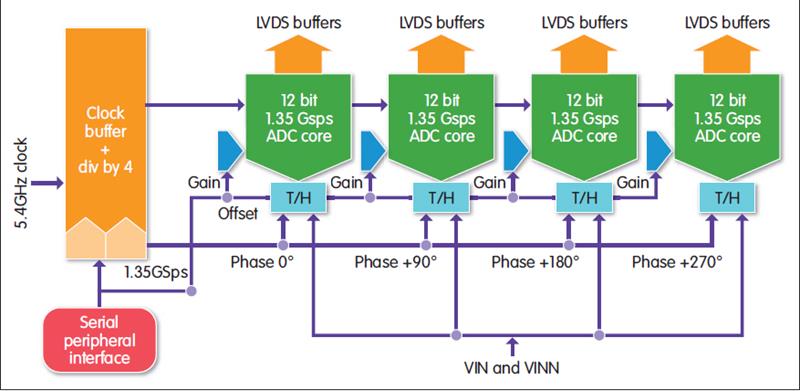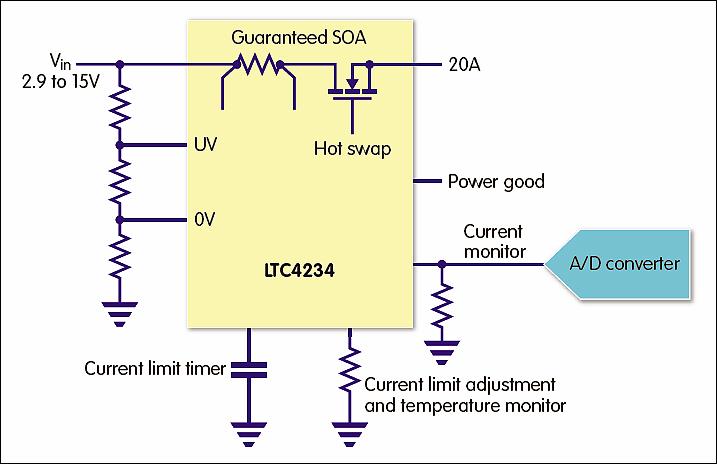Although Chelmsford headquartered e2v is probably better known for its system level expertise, it has a semiconductor operation in Grenoble that is focused on the development of high performance, high reliability semiconductor solutions for end users in the aerospace, industrial, medical, military, scientific and space sectors.
Nicolas Chantier, the company’s data converter strategy manager, explained the history. “The Grenoble site was acquired by e2v from Atmel in 2006, but the location was established by Thomson in the mid 1950s and has operated under various names since then.”
He said that high speed data converter design has been undertaken at the site since 1985, driven primarily by the French defence sector. “Both A/D and D/A converters have been developed here for military applications.”

Fig1: Simplified block diagram of he AS350 A/D converter
Expanding areas of interest
Not surprisingly, earlier products weren’t available beyond the French military, but the customer base has expanded since then. Although aerospace and defence remain important sectors, the company has added test and measurement to its areas of interest.
“We’ve been designing microwave capable A/D and D/A converters at Grenoble for the last 20 years,” Chantier noted. “We’re one of the oldest such companies in the market and about a third of the design team has been with the company for the last two decades.”
The skills resident within the Grenoble design team allow e2v to develop data converters for use at microwave frequencies. Chantier pointed to three specific targets. “The L band, at frequencies from 1 to 2GHz, the S band, from 2 to 4GHz, and the C band, at up to 8GHz. Our D/A converters can run at frequencies of up to 7GHz in the C band, while our A/D converters can work at S band frequencies.”
He noted that one of the design targets for data converters operating at those frequencies was to extend the dynamic range. “If you use the terminology of the imaging sector,” Chantier explained, “we’re looking for contrast in the RF signal. Customers for these applications will be looking for high dynamic range,” he continued, “as well as good signal to noise ratio, spurious free dynamic range (SFDR) and noise to power ratio (NPR).”
Chantier pointed to two recent e2v product launches where high dynamic range was an important feature. “The EV12DS400 D/A converter is strongly differentiated from other devices on the market,” he claimed, “while the EV12AS350A A/D converter started as a demonstrator, but will shortly be a production device.”
According to e2v, the DS400 is a ‘groundbreaking’ device, with an analogue bandwidth that stretches beyond 7GHz. This enables direct digital synthesis in the L, C and S bands. A 30ps rise/fall time makes it suitable for use in time domain applications, whilst a flexible input multiplexer enables sampling rates of up to 4.5Gsample/s.

Fig 2: The internal interleaving configuration
Multiple Nyquist zones
There are four output coding modes – NRZ, RTZ, NRTZ and RF – and e2v says the part can deliver spectral power ‘up to and beyond’ the fourth Nyquist zone, with an NPR of more than 50dB and an SFDR of 65dBc at 2.24GHz.
“It’s the first time system designers can work with multiple Nyquist zones on D/A converters at GHz frequencies,” Chantier asserted, “and it takes some time to understand what this means – a white paper discusses this in detail. Users will be able to do interesting things, such as frequency hopping and working at up to 7GHz at -3dB in one signal chain. The benefit is that system designers can reduce the number of mixers they have to implement.”
These features will enable software defined microwave systems, said Chanter, adding that e2v hopes to push to 11 or 12GHz with its next design.
Meanwhile, the AS350 is described by Chantier as the ‘most important’ A/D converter at the moment. “It has a combination of sample speed, noise floor and latency, as well as very high linearity.”
The part, focused on aerospace and defence challenges, is the first in a range of similar devices in the next couple of years, said Chantier. “Potential applications include test and measurement equipment,” he added. “Most test companies aren’t designing their own A/D converters, but need to access high sampling rates and high dynamic range. We also don’t see these companies being able to design an ASIC with this level of performance, so anticipate them continuing to buy in A/D converters for their dynamic range.”
In e2v’s opinion, the AS350 will be the only 12bit A/D converter that enables signals to be digitised at 5.4Gsample/s, a bandwidth of more than 3GHz and a latency as low as 26 clock cycles with a noise of -150dBm/Hz. The company adds the part will be free of non harmonic spurs, creating a pure signal for coders to manipulate in a range of demanding applications.
Although the AS350 is a single channel device, it has two operating modes. “When you power it up,” Chantier said, “it’s a 5.4Gsample/s device using four interleaved A/D cores. But the clock unit can be changed to enable simultaneous sampling over the four cores.
“Using the same signal chain, designers can access a high sampling range; if they want to zoom into a part of the signal, they can change the way the A/D work. It reduces the sampling rate, but provides better resolution in the area of interest, thanks to averaging techniques. It’s the only A/D converter available that can do this.”
The converter’s speed is increased to 5.45Gsample/s by running four identical A/D cores side by side, with all cores having the same input. To achieve this, a phase shift is applied to the clock signal. “We shift the phase by 90° between each core. The result is a sampling speed which is four times higher,” Chantier explained. “Clock management is integrated into the A/D converter because the approach only works if it is done in a clean way, with low phase noise. However, the user does need to provide a master clock signal with very low phase noise and jitter; we take care of things inside the chip.”
Where e2v claims an edge is in the process technology it applies. “We are using bipolar technology,” Chantier explained, “unlike our competitors, who are using full CMOS. However, we are starting to use BiCMOS.” That move, he contended, will allow e2v to take advantage of ‘the best of bipolar and the best of CMOS’.
No ITAR restrictions
Currently, e2v uses two processes: STMicroelectronics’ BiCMOS9 for the A/D parts; and an Infineon process for the D/A devices. “While e2v is fabless,” Chantier noted, “we are designing and manufacturing sets for the foundries. And, because our parts are fully European, they are not subject to ITAR restrictions.”
For the future, e2v will look more closely at power consumption – the AS350 is projected to consume 7W. “It’s always too high for customers,” Chantier said, “but we are always trading power for performance. Our options are to reduce power for the same performance or to provide more performance for the same power consumption,” he concluded.













